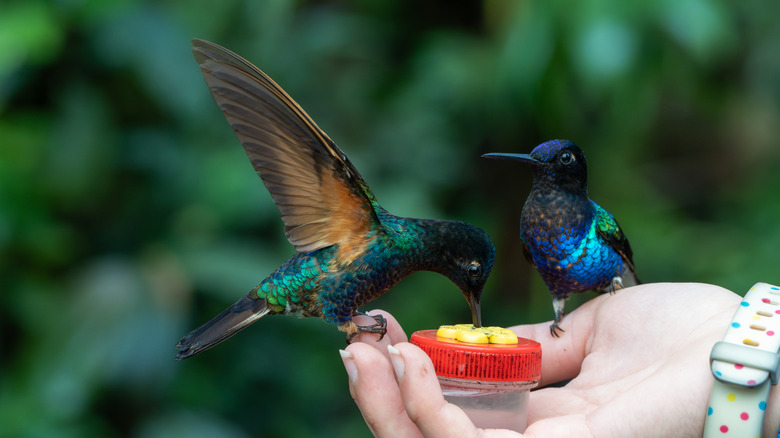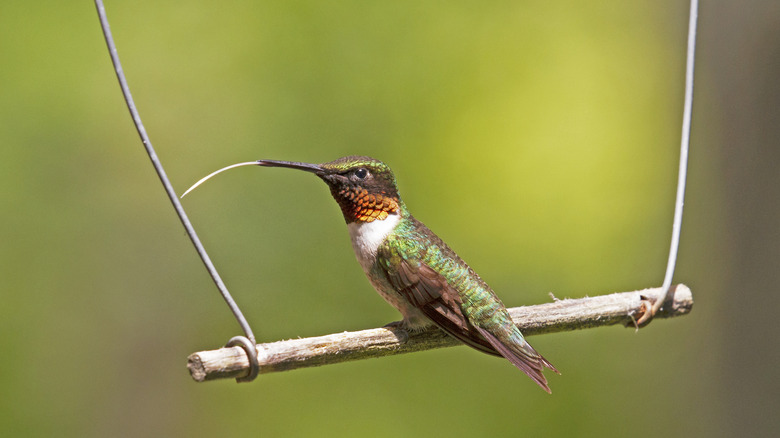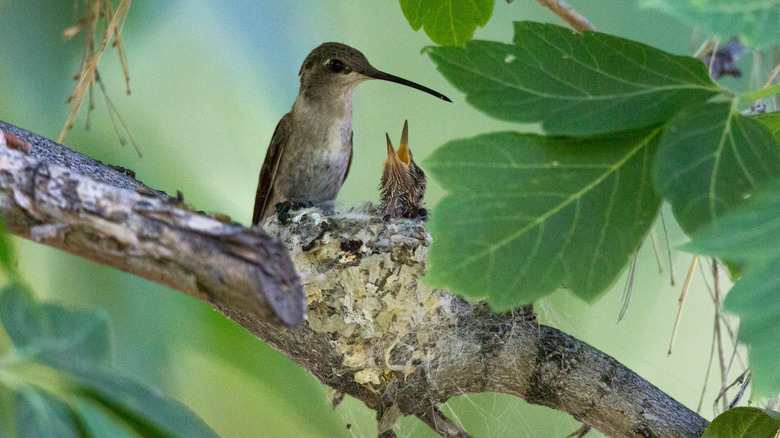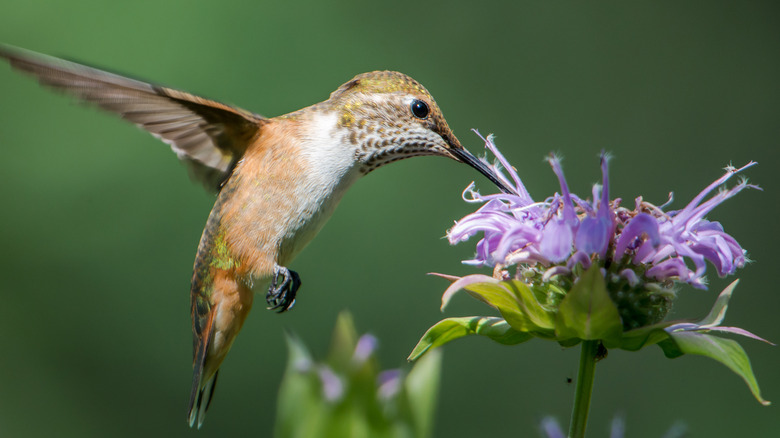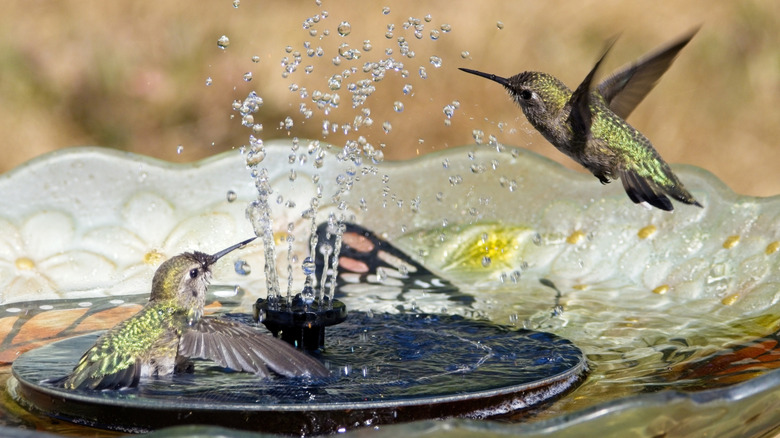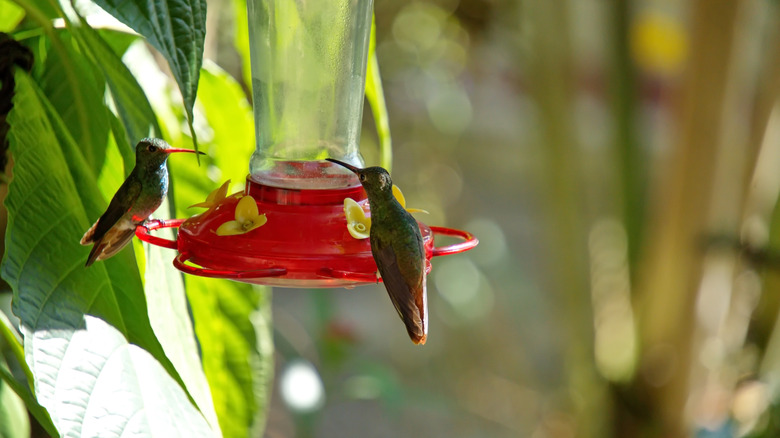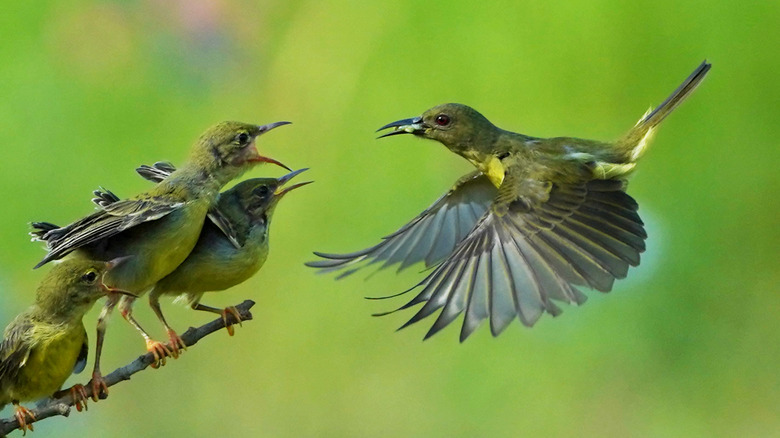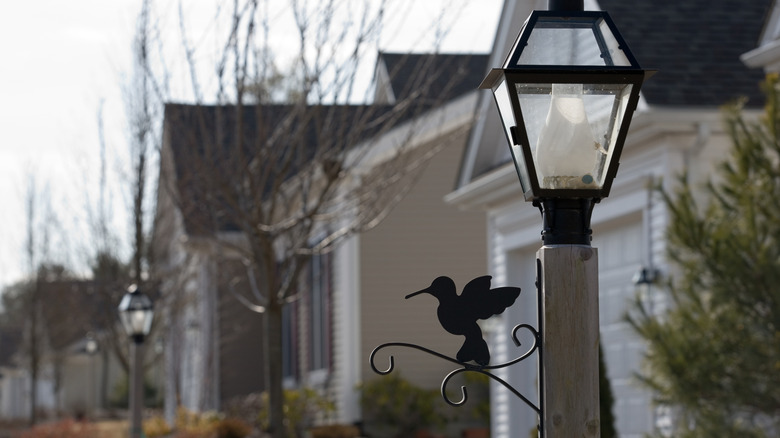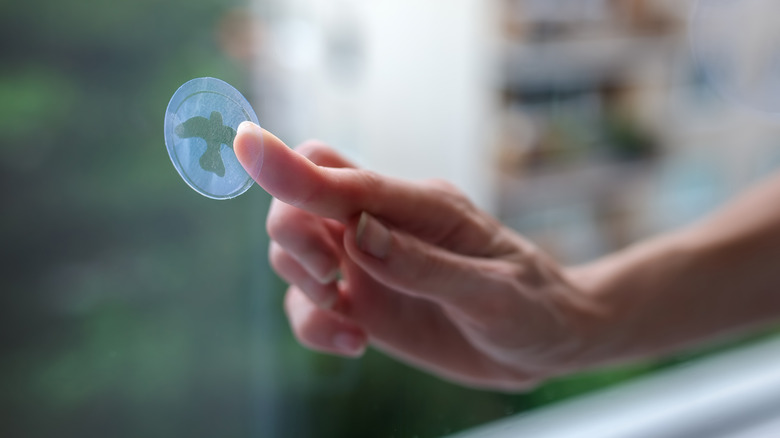8 Smart Ways To Draw More Hummingbirds Into Your Yard Or Garden
We may receive a commission on purchases made from links.
Seeing a hummingbird always feels a little bit like good luck, since they're so quick and tiny that they're often hard to spot. Taking steps to make your home welcoming to hummingbirds gives you more opportunity to admire them up close. And that's a joy, because hummingbirds are undeniably some of the coolest birds you can see in your backyard! They weigh less than marshmallows, can hover, fly backward, and can beat their wings more than 80 times per second. Their vibrant colors and patterns are beautiful to behold, with each species having its own distinct appearance.
There are some other benefits to attracting hummingbirds to your yard, too, like pollination and insect control. But really, the fact that they're fun to watch is all the reason you need. Luckily, it doesn't take much to make your yard or garden super appealing to area hummingbirds. From giving them shelter to planting the right flowers, there are some simple steps you can take to encourage more of these special little creatures to flock your way.
Learn about the species most likely to visit your yard
It's pretty easy to distinguish a hummingbird from, say, a cardinal. But the type of hummingbird you spot in your yard is tougher to discern. There are more than 360 distinct species, but only about a dozen species spend their summers in North America. You might wonder why it matters what kind of hummingbirds are most likely to appear in your area. Frankly, all the species that you're likely to see are attracted by the same basic things. But, researching the type of birds you're most likely to spot ensures you have your yard set up for optimal hummingbird conditions during the right timeframe. (Plus, it's interesting!)
For example, in the eastern half of the United States, you're most likely to see Ruby-throated hummingbirds, notable for their (you guessed it) ruby-red throats. They head south by early fall, so you can safely take down your feeders by the beginning of October. On the West Coast, a species called Anna's hummingbirds may be spotted year-round, so you can keep your feeders up all year. This species is identifiable by its emerald feathers and bright pink necks. Cornell University's All About Birds site is a good resource for learning about the birds most likely to be spotted wherever you are.
Create shelter opportunities for resting and nesting
When they're not zipping from place to place, hummingbirds like to settle down in safe, sheltered spots. Female hummingbirds are known to make their nests in shrubs and deciduous trees like oaks (aka, trees that lose their leaves every year). When you're bringing in new shrubs and trees, think about planting them around the perimeter of your yard. They're most likely to attract nesting birds there. Proximity to water and food sources will also make your trees extra inviting.
If you're looking for nests, look up! Hummingbirds tend to build their nests high off the ground. There's some variation in how high they'll go, depending on species. Anna's hummingbirds may build their nests anywhere from 6 to 20 feet off the ground, for example. Rufous hummingbirds, which can be found throughout the western U.S., build their nests up to 30 feet above the ground. Ruby-throated hummingbirds also tend to build nests in trees far above our heads, but not always. This species has been known to build nests in chains or on electrical cords. Their nests are tiny (think the size of a large thimble) and camouflaged with moss. Keep an eye out for these easy-to-miss nests when you're doing yard work so you don't disturb them.
Plant the right flowers that hummingbirds love
Flowers play a key role in attracting hummingbirds to your yard. The nectar they pull from the blooms is a big part of their diet. Since they need to refuel often, planting flowers they love is a smart way to keep them visiting again and again. They can be good for your garden, too, as hummingbirds also act as pollinators for certain plants.
Now, what to plant? The best flowers for hummingbirds meet three criteria. One, they're brightly colored in shades like red, orange, or purple. Two, their blooms are tubular, so the birds' long, narrow beaks can reach the nectar. Three, they're native to your area. For best results, group multiple hummingbird-friendly plants together in your yard. Flowering vines and shrubs can also help attract them.
Keep water accessible for bathing
Hummingbirds get hydration from the water in the nectar they eat. So, they might not need a backyard water source to drink from as much as other birds. However, they are known to enjoy bathing in the water that collects on leaves or in other shallow sources. They may be spotted flying around through the mist or spray from a sprinkler, too.
There are a few simple ways to give hummingbirds access to water in your yard. One option is a bird bath or creating a backyard water feature that hummingbirds will love. Solar fountains, suspended bubblers, and misting systems are all good examples. There are also some simple ways to modify an existing birdbath to make it more accessible for hummingbirds. Set some stones in the bowl of the birdbath to create places where hummingbirds can perch above the water level. Or, attach a water pump to a standard bird bath to create a constant flow of moving water.
Maximize your feeder strategy
Setting up hummingbird feeders can bring these little beauties to your yard day after day, and you'll always know where to look if you're hoping to catch a glimpse of one. No special or pricy supplies are necessary since hummingbirds prefer a simple solution of sugar water. It's easy to set feeders up and use them correctly if you know what you're doing, but there are some common mistakes to avoid.
Here are the basic things you need to know, starting with the feeders themselves. A basic plastic hanging one will work just fine, but there are also plenty of options for stylish hummingbird feeders. Just keep it filled with a sugar water solution. To make your own nectar, combine one part sugar with four parts boiling water. (For example, 1/4 cup of sugar and 1 cup of water.) Let the solution cool before filling the feeder.
Finally, be diligent about a cleaning routine. The nectar will turn bad after too long and can turn moldy. Empty, rinse, and refill each feeder every few days. Once weekly, take the feeders apart and wash all the parts in a solution of one part vinegar and four parts water.
Attract insects to also attract hummingbirds
Insects and spiders actually make up a big part of an adult hummingbird's diet. Bugs are their main source of protein, which is vital for birds that are nesting or feeding babies. An adult female can eat up to 2,000 insects a day! So, encouraging some insect activity in your yard could make it an especially welcoming place for hummingbird families to call home.
Avoiding the use of pesticides is one way to help keep your local hummingbirds fed. Another strategy involves putting out ripe and/or rotting fruit and fruit scraps near your feeders. Hanging things like banana peels, strawberry stems, and peach pits should bring a flurry of fruit flies for the birds to eat. The downside of this strategy is that you might attract other critters.
Engage your neighbors to create more welcoming yards
Making your yard an oasis for hummingbirds is great, but you might not see a ton of activity if you're surrounded by other yards that aren't set up to attract them. If you can get your neighbors to make their own gardens more friendly to hummingbirds, you may notice an uptick in activity. The more nesting space, food sources, and water that are available nearby, the more appealing your neighborhood becomes to any hummingbirds passing through.
Your power is limited here, of course. Whether your neighbors want to make their yards more welcoming to hummingbirds is obviously not up to you. What you can do is share your own excitement about the birds you spot around your home. Share photos of hummingbirds you spot in your yard and tips for attracting them with neighbors and through neighborhood groups like NextDoor. Who knows, maybe it'll inspire a few people nearby to put up their own feeders.
Maintain a safe environment to prevent harming the hummingbirds
As you work on attracting more hummingbirds to your yard, take steps to keep them safe so they can keep coming back. Two of the most deadly threats to hummingbirds around your home are predators, like cats, and glass collisions. Both house cats and feral cats can kill or maim hummingbirds. Keeping your own pet cats indoors is about all you can do here, since feral cats are hard to deter.
There are some things you can do to minimize glass collisions, though. And that's important because hummingbirds seem to be at especially high risk of crashing into windows and glass doors. Installing screens on the outside of your windows reduces glare so birds won't see the sky reflected in the glass on sunny days. Applying a product like OFFO Bird Reflective Tape or decals to the outsides of windows and glass doors is an even simpler and cheaper solution.
